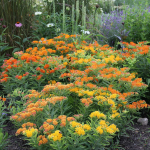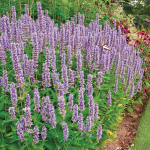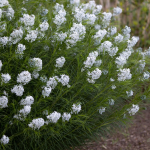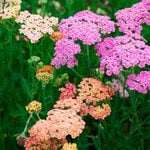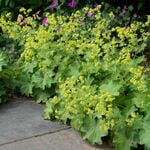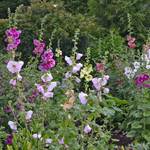Product Details
Hay-scented Fern is a fast-growing deciduous native that forms colonies. It can become invasive but is extremely useful as a ground cover for sun or shade—just don't expect it to be a nice neighbor to choice little shade plants. Reserve Hay-scented Ferns (so called because the 36″ fronds do indeed smell of hay when bruised) for locations where you need to cover large expanses quickly and inexpensively with something deer resistant, attractive, and undemanding.
For more information on the growing and care of Ferns, click on Growing Guide.
Shipping
HOW PLANTS ARE SHIPPED
The size of the plants we ship has been selected to reduce the shock of transplanting. For some, this means a large, bareroot crown. Others cannot travel bareroot or transplant best if grown in containers. We ship these perennials and annuals in 1 pint pots, except as noted. We must point out that many perennials will not bloom the first year after planting, but will the following year, amply rewarding your patience. We ship bulbs as dormant, bare bulbs, sometimes with some wood shavings or moss. Shrubs, Roses, vines, and other woody plants may be shipped bareroot or in pots. The size of the pot is noted in the quick facts for each item.
WHEN WE SHIP
We ship our bulbs and plants at the right time for planting in your area, except as noted, with orders dispatched on a first-come, first-served basis by climate zone. We also ship a wide range of containers and planters, tools, supplies, fertilizers, garden wear, garden decor items, as well as indoor decorations like wreaths and dried bouquets when available. Estimated dates for shipping are indicated in the green Shipping Details box for each item. Please supply a street address for delivery. Kindly contact us with two weeks notice, if you'll be away at the expected time of delivery.
OUR GUARANTEE
We guarantee to ship plants that are in prime condition for growing. If your order is damaged or fails to meet your expectations, we will cheerfully replace or refund it. Please contact our Customer Service Department at 1-800-503-9624 or email us at [email protected]. Please include your order number or customer number when contacting us.
Reviews
Average Customer Rating:
 (3 Reviews)
Write a Review
(3 Reviews)
Write a Review
Sort by:
3 out of 3 died 
CSB from Brooklyn, NY
Speading like crazy 
Ana from Foretville, Ct
Great for partial sun, sun and wooded areas - requires watering to take root and watering when soil is exceptionally dry.
bare root delivery 
judy from Marlborough, ct
Growing guide
Indispensable for shady areas, these delicate plants make the hottest summer day seem cooler. Great variety exists in form and size, giving the creative gardener many planting options. Most Ferns are slow growing and can take several years to reach their mature size, which varies greatly between varieties.
Light/Watering: All Ferns thrive in light to heavy shade. A few, such as Lady Ferns (Athyrium filix-femina) will grow in full sun in the North, provided the planting site is damp. Water Ferns regularly if rain is not sufficient, and do not let the soil get completely dry. A 2″ thick mulch of composted leaves or pine needles will help keep roots cool and damp.
Fertilizer/Soil and pH: Ferns prefer soils high in organic matter that are well-drained but do not dry out. Most will tolerate poor soils and a pH of 4 to 7; Maidenhair Fern (Adiantum) prefers a more alkaline soil between pH 7 to 8, but will grow at a lower pH. Apply fertilizer in spring, just after new growth has begun. Ferns are very sensitive to fertilizers; use a slow-release fertilizer when new growth appears in early spring. For initial planting of bareroot plants, lay the mat formers (Adiantum, Athyrium, Dennstaedtia, and Dryopteris) with buds and old fronds facing up in a shallow hole and cover with an inch of soil. Plant bareroot crown-formers (Matteuccia, Osmunda, Phyllitis, and Polystichum) with the growing tips just barely showing through the soil surface. Ferns are notoriously slow to send up new growth after planting, but good things come to those who wait.
Pests/Diseases: None serious enough to worry about, other than the occasional slug attack. Fight back with bait or diatomaceous earth sprinkled around the base of the fronds.
Companions: Ferns are lovely with other shade-lovers such as Alchemilla, Brunnera (False Forget-me-not), Dicentra (Bleeding Heart), Hosta, Mertensia (Virginia Bluebells), Phlox divaricata, Pulmonaria (Lungwort), Tiarella (Foam Flower), and Viola. They add fabulous texture to woodlands and landscape plantings. Ferns are deer-resistant, so they make an excellent choice for a woodland garden where deer are a problem.
Dividing/Transplanting: When Fern fronds appear to be smaller, or the clump has a bare center, it is time to divide. Some Ferns form crowns while others grow as mats of fibrous roots. Dig up the whole clump and take 6″-square pieces from the most vigorous growth. Replant at the original depth and water well.
End-of-Season Care: Cut fronds back after a killing frost, and apply a winter mulch of salt marsh hay or evergreen boughs to help prevent winter heaving.
Calendar of Care - Ferns
Early Spring: Divide or transplant as soon as new growth appears, and water well if it is unseasonably dry, as plants prefer an evenly moist soil. Fertilize gently with a slow-release fertilizer or use an organic mulch. Recently planted Ferns may be slow to appear, but be patient.
Mid-Spring: Water consistently if rainfall is not sufficient to keep soil moist. Apply a 2″ thick mulch of composted leaves or pine needles.
Late Spring: Watch for slug or snail damage and treat as necessary.
Summer: Continue regular watering as needed to maintain soil moisture.
Fall: Cut foliage back to soil level when it dies back after a heavy frost. When the ground freezes, mulch to protect plants from heaving out of the soil in winter.

